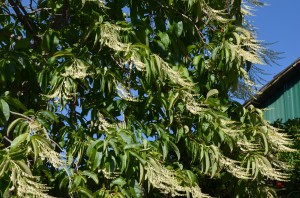Sourwood (Oxydendrum arboreum), aka lily of the valley tree, is one of the most beautiful U.S. native flowering trees (USDA hardiness zones 5-9). However, attempting to establish one in your landscape may prove challenging.
The tree grows in sparse populations from eastern Tennessee, western North Carolina, and Georgia Piedmont. It grows naturally to 20-30 feet tall shrub and 35-40 feet tall tree. Most trees grow in a narrow pyramidal form, less than 15 to 20 feet wide.
Sourwood offers four seasons of landscape beauty. Delicate-looking white fragrant flowers (racemes) open in early July and may bloom 3 to 4 weeks. The pendulous 10 to 16 inch long creamy bell-shaped floral sprays drape from the growing tips of branches. The seed capsules turn gray in late fall and persist through the winter.
Sourwood‘s spectacular fall leaf color is an array of burgundy, scarlet, and purple lasting over 2 to 3 weeks. Its deeply fissured bark is similar to persimmon, and easier to view after autumnal leaf drop.
Sourwood prefers well-drained acidic soil and sited in full or partial sunlight. A tree in heavy shade does not bloom as well or provide a spectacular fall foliage as one in mostly full sunlight.
Few cultivars are available. Reasons to nurture a sourwood tree in your landscape: July flowering time, lily of the valley floral sprays, awesome red fall color, major winter food source (seed) for birds and wildlife, and delicious sourwood honey. Flowers attract numerous bees and butterflies.
See also blog titled: “Tips For Growing Sourwood”


 Posted in
Posted in 
